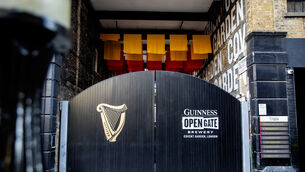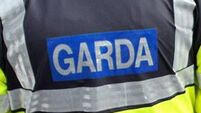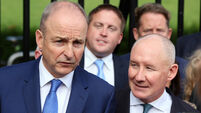From austerity poster boy to problem child
IRELAND’S reputation as the poster child for austerity is under threat at just the wrong time.
With the State poised to fully re-access international bond markets at the end of the year and abandon the security of the bailout programme, the economy has slid back into recession.
“The major challenges still facing the economy undermine the view that the country has forged an escape route for the other troubled peripheral countries to follow,” said Jonathan Loynes, chief European economist at Capital Economics in London. “It’s too soon to conclude that Ireland has found its way of the crisis.”
Borrowing costs tumbled during the past two years as the Government slashed the fiscal deficit and eased its bank debt burden. The 10-year yield is at about 3.86%, down from more than 9% when a bailout was requested in Nov 2010. The economy, though, is struggling to grow as debt-laden consumers cut spending and exports drop.
“There are the first signs of a domestic recovery, but it’s going to be grindingly slow,” said John Reynolds, chief executive at KBC Bank Ireland. “We were never going to see an overnight resurrection of the economy.”
The premium Ireland pays to borrow for a decade relative to Germany is 2.18 percentage points, while bailed-out Greece and Portugal pay premiums of 8.02 percentage points and 4.88 points, respectively. Investors charge Italy 2.52 percentage points more than Germany for 10-year cash, while Spanish debt yields 2.82 points more than bunds.
“The bond market tends to focus on more forward- looking indicators, like PMI survey figures for both Ireland and the euro area,” said Rossa White, an economist at the National Treasury Management Agency.
“Those numbers signal that the picture for the rest of the year is probably more positive than the first-quarter numbers suggest.”
The improvement in investment sentiment toward Ireland reflects Government progress on the economy. The budget deficit has narrowed to about 7.5% of gross domestic product (GDP), from 11.5% in 2009.
More tax increases and spending reductions will shrink the shortfall to about 3% by 2015, according to Government forecasts. Finance Minister Michael Noonan also won a deal to avoid paying down the debt linked to the bailout of the former Anglo Irish Bank until 2038, and has been given more time to repay the bailout loans.
Unemployment has dropped to 13.5%, the lowest since 2010, while overseas buyers, including New York-based Blackstone Group LP, have snapped up Irish property in the wake of the worst property crash in Western Europe. Ireland has already made a partial return to long-term credit markets.
The nation had about e30bn of cash and other financial assets on hand at the end of June.
The cost to insure against Ireland reneging on debt payments using five-year credit-default swaps has dropped to 141 basis points from a peak of 1,196 on Jul 18, 2011.
“The markets see that there is a lot of cohesion and a lot of purpose to what’s being done in Ireland,” said Mr Reynolds at KBC. “Real foreign money is being invested in Ireland. You ignore the market perception of things at your peril.”
The underlying economy remains fragile. GDP shrank 0.6 in the first quarter, driving Ireland back into recession for the first time since 2009. Retail sales fell 1.6% in June from May, the biggest monthly decline since November, and consumer confidence dimmed again last month.
Marks & Spencer Plc said last week it will shut four stores and shed 180 workers, saying the past few years have been “very challenging” and the outlook hasn’t improved.
Exports also are faltering, with overseas sales dropping 1.9% in the first half of the year, the Irish Exporters’ Association said this week.
The organisation forecast that exports will drop 1.6% this year, slashing a May estimate for 3.3% growth.
“Failure of the EU economies will always create major problems for our exporters,” said John Whelan, head of the Irish Exporters’ Association. “The first six months of the year have been more difficult than expected.”
Analysts are slashing their forecasts for economic growth, with the country’s central bank last month lowering its 2013 estimate to 0.7% from 1.2%.
The economy will grow by 0.8% this year, according to the median forecast of 25 analysts surveyed by Bloomberg in June. That’s down from a forecast of 1.2% in March.
“Ireland has managed to eke out enough growth to make all its targets so far,” said Mr White at the NTMA.
“Unless something happens to significantly change that, I don’t think investors are going to be overly concerned.”
At Capital Economics, Loynes is more pessimistic, estimating the economy will shrink 0.5% this year, before expanding by about the same amount next year.
The difficulty for Taoiseach Enda Kenny is that slower growth makes the debt burden heavier. Capital Economics forecasts gross Irish debt, which doesn’t include the State’s cash on hand, may rise to as much as 140% of GDP, rather than peaking at 123% this year as estimated by the Department of Finance.
That may “prompt markets to reassess their perceptions of Ireland’s creditworthiness, threatening higher bond yields,” Loynes said.
“We think it’s premature to conclude with any certainty that Ireland can now safely stand on its two feet.”















